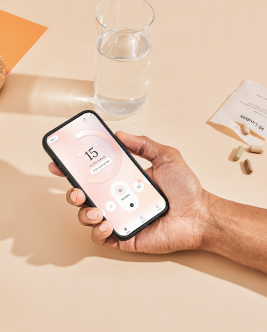science
How Long Does It Take for Vitamin D to Work? What to Expect
On This Page

Vitamin D deficiency is quite common. More time in the sun can help increase levels, but how long will it take to get your vitamin D up to a healthy level?
Vitamin D is often called the “sunshine vitamin” because the body needs UV radiation from the sun’s rays to produce it. If you’ve made lifestyle changes in order to help improve your levels of the vitamin, you might be wondering how long it will take to see results. You might also ask: “How long should I take a vitamin D supplement?” We’re investigating those questions to find out more about this commonly deficient vitamin.
How long does it take for vitamin D to work?
Vitamin D supplementation doesn’t offer an overnight change. In fact, the one study showed that the largest increase in vitamin D levels came between three to nine months after beginning supplementation. Research hypothesized that adding vitamin D supplements can be expected to raise the vitamin D level, measured as serum 25(OH)D, by about 1 ng/mL for every 2.5mcg (100 IU) of additional vitamin D each day. However clinically speaking, the dose of vitamin D needed to raise serum levels is generally higher and the dose needed varies from person to person. This study found that vitamin D doses between 75-125 mcg (3000-5000 IU) can maintain healthy serum levels in healthy men.
Since everyone’s body is different, there’s no strict guideline on when you will notice results from vitamin D supplements. How long it takes to see results is largely dependent on where your vitamin D levels were prior to supplementing and how well your body absorbs the nutrient. If you have a clinical deficiency, you may notice positive effects shortly after beginning a vitamin D supplement. Consistency is key to seeing positive results and supplements should be taken daily for noticeable change.
How much Vitamin D to Take Daily
The Recommended Dietary Allowance (RDA) of vitamin D for ages 1-70 years old is 600 IU, or 15 mcg, daily, and 800 IU, or 20 mcg, daily for adults over the age of 70.
A dose of 1,000-2,000 IU, or 25-50 mcg, may be helpful as a daily dose for maintaining adequate levels of vitamin D.
The Tolerable Upper Limit (UL) of vitamin D established by the Food and Nutrition Board is 4,000 IU, or 100 mcg, daily for adults. However, those with deficiency may benefit from higher doses for a period of time until blood values achieve adequate levels. Blood levels of vitamin D should be checked first before supplementing with higher doses. It’s a good idea to consult your healthcare provider before beginning any supplementation or considering larger doses. Your healthcare provider can help you to determine which dosage is appropriate for your body’s specific needs.
How long should you continue taking a vitamin D supplement?
Supplementing with vitamin D can have beneficial effects when done consistently each day. Since the main source of vitamin D is through sun exposure to the skin, it’s especially important to supplement during times of less sunlight. This could mean supplementing with vitamin D during the fall and winter months and taking a break during the summer, particularly if you spend significant time outdoors and in the sun. It may also be helpful to supplement in the summer if you do not get enough sunshine. It’s best to talk to your doctor to develop a vitamin D supplement plan that’s right for you.
What is a Vitamin D Deficiency?
There are differences in opinion amongst some guidelines about the definition of vitamin D deficiency and vitamin D insufficiency. However, the Institute of Medicine defines a vitamin D deficiency as a level of serum 25-OH vitamin D less than 20 ng/mL. The Endocrine Society further defines vitamin D insufficiency as 21 - 29 ng/mL.
According to the NHANES data from 2005 to 2006, around 41% of Americans are vitamin D deficient. Getting your levels checked periodically can be a helpful practice to stay on top of getting enough vitamin D for your health.
Symptoms of low vitamin D
Vitamin D is a fat-soluble vitamin that supports bone health, immune function, and countless other systems of the body. Vitamin D deficiency had been a serious issue prior to the mass fortification of foods like milk and other dairy products. It still is common throughout the world. While rare, severe vitamin D deficiency can result in rickets. The vitamin was traditionally used years ago to treat rickets. Because vitamin D plays an important role in helping our bodies absorb calcium, bone weakening is a major concern for people with low levels. Other symptoms of vitamin D deficiency may include:
Symptoms are usually more common only as blood levels fall into the deficiency range of less than 20 ng/mL.
Who is at risk for a vitamin D deficiency?
Since sunlight is an excellent way to get vitamin D, people who do not get enough sun exposure on their skin may be at risk for low vitamin D levels. This includes people who use sunblock regularly, as sunscreens are formulated to block UVB radiation, which is what the body needs to synthesize vitamin D. Also, people who have darker skin may have more of a challenge absorbing UVB rays because of the higher levels of melanin in their skin, which can act as a natural sunblock allowing for less absorption of UV radiation.
Other people who may be at risk for a vitamin D deficiency include people who typically cover their body in clothing and people who do not go outside often, since UVB radiation cannot penetrate through windows in offices, homes, or cars. Living in an area with high pollution or a geographic location with a high latitude, where the sun’s rays are the weakest, may also be at risk for low levels of vitamin D. Low intake of vitamin D is more common in people who are lactose intolerant or have a milk allergy. Lastly, people with digestive issues and difficulty processing fats are at higher risk of vitamin D deficiency since absorption of fat-soluble vitamin D may be more difficult.
Health Benefits of Vitamin D
Vitamin D plays a crucial role in maintaining overall health. It supports calcium absorption, promoting strong bones and teeth. Additionally, vitamin D supports immune system function and it contributes to muscle strength. Adequate levels of vitamin D have been associated with a lower risk of cardiovascular issues when combined with healthy diet, exercise, adequate sleep, hydration, and stress management.
Best ways increase your levels of vitamin D
There are many options to increase your vitamin D levels. Here we’ll explore the three most common and effective ways of adding a larger dose of vitamin D to your life.
Sunshine
Sunlight is one of the most accessible sources of vitamin D. It’s free and can typically be accessed every day. Exposing at least 40% of skin, not covered by clothing or sunblock, to about 15 to 30 minutes of sunlight every other day is a good way to get the UVB radiation necessary for vitamin D synthesis in the body.
Yes, UVB radiation is in the same type of sunlight we’ve been warned about for the damage it can do to our skin. Since sun exposure can cause premature aging as well as other health risks, it’s essential to moderate our exposure. Don’t remain in the sun for too long. If your skin is red or sunburnt after your sunlight session, you may be staying in the sun for too long.
Diet
Only a small variety of foods naturally contain vitamin D and the amounts are generally small. Diet should be looked at as a supportive way to add vitamin D to your body, but not as the primary method.
Vitamin D2, which is naturally found in some mushrooms as well as added to some foods like plant-based milks, is absorbed similarly to vitamin D3 but may be less effective at raising or maintaining blood levels of vitamin D.
Vitamin D is often added to dairy products since vitamin D can help absorb calcium naturally present in dairy. Since vitamin D is a fat-soluble vitamin, it naturally is present in a few foods that also contain fat.
Foods that contain vitamin D3:
- Cod liver oil
- Rainbow Trout
- Sockeye Salmon
- Sardines
- Eggs
Foods that contain vitamin D2 or are fortified with vitamin D:
- White Mushrooms (if exposed to UV light)
- Plant-based milks fortified with vitamin D
- Milk and some dairy products fortified with vitamin D
- Cereals fortified with vitamin D
Vitamin D supplements
Vitamin D in the form of dietary supplements is recommended as a way to ensure your body gets adequate levels of vitamin D. These supplements are best taken with food, particularly foods which contain fat. This is often why you’ll see vitamin D supplements paired with the largest meal of the day to aid in absorption. This has been shown to actually increase levels by as much as 50%.
Care/of offers two vitamin D supplements, the Sunny D3 option is vegetarian and non-GMO and the vegan formulation is made from sustainable algae. Both provide 25 mcg (1,000 IU) of Vitamin D3.
The Bottom Line
Inadequate vitamin D is all too common and can cause fatigue and mood changes, as well as issues with bones, muscles, and the immune system.
Getting enough sun exposure to the skin is an excellent way to naturally produce vitamin D in the body. Supplementing with a vitamin D supplement can help ensure you get enough of the nutrient, since vitamin D does not naturally occur in many foods.



